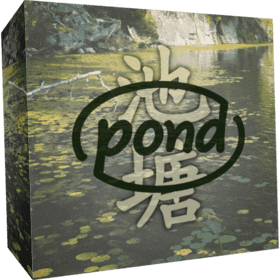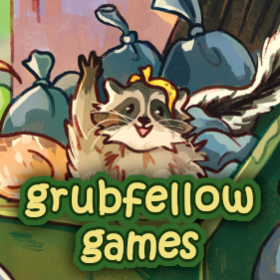Pond
 Bevolk en navigeer door de vijver met eieren, zwemmende kikkervisjes en hoppende kikkers. Verplaats en ontwikkel je stukken door levenscycli om bijpassende sets symbolen te creëren. Plan je beurten zorgvuldig terwijl je punten scoort voor jezelf en je tegenstander in deze doordachte wedstrijd van evoluerende strategie.
Bevolk en navigeer door de vijver met eieren, zwemmende kikkervisjes en hoppende kikkers. Verplaats en ontwikkel je stukken door levenscycli om bijpassende sets symbolen te creëren. Plan je beurten zorgvuldig terwijl je punten scoort voor jezelf en je tegenstander in deze doordachte wedstrijd van evoluerende strategie.
Aantal spelers: 2
Spelduur: 8 mn
Complexiteit: 2 / 5
Speel Pond en 1194 andere spellen online.
Geen download nodig - speel rechtstreeks in je webbrowser.
Met je vrienden en duizenden spelers van over de hele wereld.
Gratis.

Speel Pond en 1194 andere spellen online.
Geen download nodig - speel rechtstreeks in je webbrowser.
Met je vrienden en duizenden spelers van over de hele wereld.
Gratis.

Samenvatting van de regels
Overview
Be the first to score 10* or more pieces of your own color. (*Winning score depends on game variation.)
Setup
Pond is played by two players on a 4x4 board. Each player starts with 13* Eggs of their color in their spawn. (*Spawn size depends on game variation.)
Turn
Each turn consists of three steps: Action, Develop, Score
- Action: As your action, you can either Place an Egg, Move a Tadpole, or Move a Frog.
- Place an Egg: Place an Egg from your spawn on any empty space on the board. Eggs themselves cannot move while on the board.
- Move a Tadpole: Move a Tadpole of your color to an orthogonally adjacent empty space
- Move a Frog: Move a Frog of your color 1 or 2 spaces in an orthogonal straight line to an empty space. The Frog may hop over an adjacent piece to reach an empty space on the other side.
- Develop: Once you have completed your action, the Develop step occurs, causing some pieces to change symbols.
- From where your moved piece now resides, every orthogonally adjacent piece develops, regardless of color.
- To develop a piece, move it along its life cycle: An Egg becomes a Tadpole, a Tadpole becomes a Frog, and a Frog becomes an Egg.
- Developing a piece does not change its color.
- Development is not optional, and pieces must always develop in the same order. You can never skip development or develop backwards.
- Score: Finally, score any sets you have now created.
- A set is a group of 3 or more matching symbols in a straight horizontal or vertical line, regardless of owner. This means that sets can consist of pieces of a single color or pieces of both colors.
- These pieces are removed from the board and given to their owner to form their owner's scoring pile (i.e. You might not be scoring for yourself.)
- In the instance of intersecting sets, all components score. (e.g. In a "+" configuration, all 5 would score, but the middle one does NOT double score.)
After a player has played an action, developed all necessary pieces, and scored any resulting sets, it becomes their opponent's turn.
Game End
The game ends when a player has scored 10 or more of their own pieces. Then, the player with the most scored pieces wins the game. (e.g. If one player reaches 11 points, and their opponent simultaneously reaches 10 points at the same time, 11 beats 10.) If the score is tied, then the game ends in a draw.
The game also ends if a player is unable to perform an action on their turn. If a player has no legal actions, that player loses the game. This secondary win condition is called Elimination.
Game Mode Variations
- Standard: The game is played on a 4x4 grid. Each player begins with 13 eggs in their spawn, and the win condition is 10 points.
- Mini: The game is played on a 4x4 grid. Each player begins with 10 eggs in their spawn, and the win condition is 7 points.
- Big: The game is played on a 5x5 grid. Each player begins with 14 eggs in their spawn, and the win condition is 10 points.

